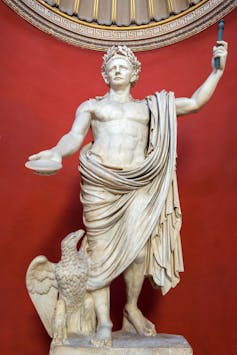When we look back over years past, whose achievements make it into the history books? There are important stories and contributions that have long been overlooked because the people responsible were part of a marginalised group.
But even well-known figures’ stories are sometimes incomplete when told through popular narratives. There are many famous historical figures who were disabled, but this part of their identity is often left out of discussions about their lives.
Disabled people’s historical contributions are often represented through the narrative of “overcoming the odds”. Many argue this can be objectifying or harmful. Instead, we should try to understand how their experiences of disability may have shaped their life, work or activism.
In my PhD research, I am studying the lives and treatment of physically disabled enslaved men in the pre-civil war US south. For these men, disability informed their sense of self, labour roles and status in the community.
While these men were often considered to be economically less valuable by slaveholders, they frequently performed valuable labour for their communities through tasks such as caring for children or providing nourishment for field workers.
Learning about the experiences of disabled people in history can give us a more complete understanding of a society during a particular time period. Here are four people who made important contributions to history, whose disabilities are often omitted from their stories.
Dorothea Lange
Born in 1895 in New Jersey, Dorothea Lange was an influential photographer and photojournalist. Working for the Farm Security Administration, a government agency set up to tackle rural poverty during the Great Depression, she focused her camera on people suffering from the severe economic consequences of the depression.
Lange’s photography established relationships between people regardless of religion, class, gender, or race, building a sense of empathy during tense times.
When she was seven, Dorothea contracted polio, which weakened her leg and left her with a limp for the rest of her life. Lange described her disability as “the most important thing that happened to me. It formed me, guided me, instructed me, helped me and humiliated me. All those things at once. I’ve never gotten over it, and I am aware of the force and power of it”.
Rosa May Billinghurst
British suffragette Rosa May Billinghurst was born in 1875 in Lewisham, London. As a child, she contracted polio and was partially paralysed. She used a tricycle wheelchair to assist with movement throughout her life.
As a young woman, she and her sister Alice developed an interest in social work, working at the Greenwich and Deptford Union Workhouse. She later recounted the profound impact that this had on her, influencing her decision to become involved with the suffrage movement.
She stated in 1913: “My heart ached … I thought surely if women were consulted in the management of the State, happier and better conditions must exist for hardworking, sweated lives such as these.”
She was actively involved in the Women’s Liberal Association and in 1907 founded a chapter of the Woman’s Social and Political Union. Her first arrest in relation to her activism was in 1911, for obstructing police at a demonstration in Parliament Square. She would obstruct officers with her tricycle, using her crutches to propel herself forward.
Sojourner Truth
Born into slavery, at some point probably between 1797 to 1800, in Swartekill, New York, Isabella Baumfree later gave herself the name Sojourner Truth in 1843. The abolitionist travelled around the northern US, preaching against the ills of slavery.
Her enslaver, John Dumont, had promised her freedom a year before the final date of emancipation in New York state. He later claimed that an injury in Truth’s hand made her less productive, and that therefore he would not free her. Academics have argued that Truth concealed her disability in order to present an image of strength.
Truth was the first black women in US history to win a court case against a white man. Upon learning that her five-year-old son had been illegally resold to Alabama by Dumont, she took the issue to the New York supreme court and filed suit against his new enslaver.
She is also remembered for her “Ain’t I a Woman?” speech at the 1851 Women’s Rights Convention, in which she highlighted the unequal treatment of black men and women in the US.
Claudius, Roman emperor
The fourth emperor of Rome, Tiberius Claudius Caesar Augustus Germanicus, ruled from AD 41 to 54. Claudius is described as having a range of physical disabilities and illnesses throughout his life, including tremors in his hands, a limp and a stammer.

Claudius had an interest in history, and produced volumes on the history of Carthage, the Roman republic and many other topics.
He is best known for expanding the Roman empire and improving the judicial system of Rome. Such improvements included issuing an edict that sick, enslaved people who were abandoned would be set free, rather than being reclaimed by their enslavers if they recovered.
Some researchers argue that Claudius experienced negative assumptions about his ability to rule, related to prejudice “which prized physical appearance and demeanor as highly as policy and initiative”.
While Claudius lived thousands of years ago, the prejudice he may have experienced is reminiscent of the ableist attitudes that some people hold towards disability today. Hopefully, by sharing more of these hidden stories from history, this perception will continue to change.
Mia Edwards receives funding from Midlands4Cities AHRC Research Council.
This article was originally published on The Conversation. Read the original article.







